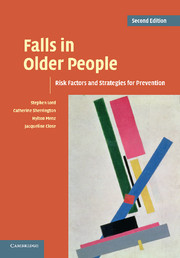Book contents
- Frontmatter
- Contents
- Preface
- Acknowledgements
- Part I Epidemiology and risk factors for falls
- Part II Strategies for prevention
- 10 Exercise interventions to prevent falls
- 11 Exercise interventions to improve physical functioning
- 12 Medical management of older people at risk of falls
- 13 Assistive devices and falls prevention
- 14 Modifying the environment to prevent falls
- 15 Prevention of falls in hospitals and residential aged care facilities
- 16 A physiological profile approach to falls risk assessment and prevention
- 17 Research into practice
- Part III Research issues in falls prevention
- Index
- References
15 - Prevention of falls in hospitals and residential aged care facilities
Published online by Cambridge University Press: 03 May 2010
- Frontmatter
- Contents
- Preface
- Acknowledgements
- Part I Epidemiology and risk factors for falls
- Part II Strategies for prevention
- 10 Exercise interventions to prevent falls
- 11 Exercise interventions to improve physical functioning
- 12 Medical management of older people at risk of falls
- 13 Assistive devices and falls prevention
- 14 Modifying the environment to prevent falls
- 15 Prevention of falls in hospitals and residential aged care facilities
- 16 A physiological profile approach to falls risk assessment and prevention
- 17 Research into practice
- Part III Research issues in falls prevention
- Index
- References
Summary
Many of the risk factors and prevention strategies outlined in previous chapters are also relevant to falls among hospital patients, and residents of hostels and nursing homes. This chapter discusses risk factors for falling which seem to be particularly important within hospitals and residential aged care facilities. There have been many programmes developed which aim to reduce falls in institutional settings and a number of these have now been evaluated in randomized controlled trials (RCTs). This chapter outlines the results of trials conducted to date and discusses programme features likely to be important for preventing falls in institutional settings.
Incidence and risk factors
Hospitals
Falls among inpatients are a key issue for hospitals. Falls in hospitals increase morbidity, prolong hospital stays, and strain the resources of the healthcare system, family and community. Up to one-quarter of people fall during their time in a rehabilitation hospital or ward. These figures are even higher for particular diagnoses. Up to 40 % of stroke patients fall while in a rehabilitation unit.
Many falls in hospitals occur around patients' bedside and ward area, with up to 43 % of falls occurring from (or near) patients' beds. Peak periods for patient falls coincide with peak periods of patient activity. A number of studies have found falls to be associated with getting in and out of beds and chairs, walking, and toileting.
- Type
- Chapter
- Information
- Falls in Older PeopleRisk Factors and Strategies for Prevention, pp. 311 - 332Publisher: Cambridge University PressPrint publication year: 2007



